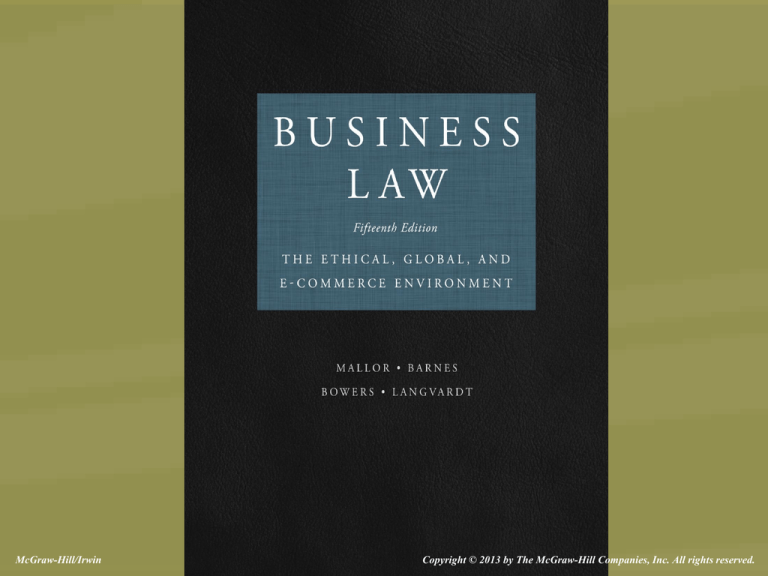
McGraw-Hill/Irwin
11-1
Copyright © 2013 by The McGraw-Hill Companies, Inc. All rights reserved.
P
A
R
T
Contracts
3
•Introduction to Contracts
•The Agreement: Offer
•The Agreement: Acceptance
•Consideration
•Reality of Consent
11-2
P
A
R
T
Contracts
3
•Capacity to Contract
•Illegality
•Writing
•Rights of Third Parties
•Performance and Remedies
11-3
C H A P T E R
11
The Agreement:
Acceptance
Make your
bargain before
beginning to
plow.
Arab proverb
11-4
Learning Objectives
• Explain elements of acceptance
under common law and the UCC
• Determine how acceptance can
be communicated, including by
silence
• Determine when oral acceptance
is effective
11-5
Requirements for Acceptance
• Acceptance must be by clear expression
by offeree of intent to be bound by terms
of offer and communicated to offeror
– Only offeree may accept offer
– If offer calls for performance, then
performance is acceptance
– Offeror may specify manner of
acceptance
• Example: “notify of acceptance in writing”
11-6
Mirror Image Rule
• Traditional contract law rule required
acceptance to be the mirror image of
the offer
– Example: Pride v. Lewis
• Currently, judges hold that only
material variances between an offer
and an alleged acceptance result in
an implied rejection of the offer
11-7
The UCC & Variance of Terms
• UCC 2–207 allows contract formation even
when there is some variance between terms
of offer and terms of acceptance
– A definite and timely expression of acceptance
creates a contract, even if it includes terms
different from those stated in offer or if it states
additional terms offer did not address [2–207(1)]
– Belden v. American Electric Components, Inc.
11-8
11-9
Communicating Acceptance
• With instantaneous forms of communication,
knowing when acceptance occurs is easy
– Non-instantaneous forms (postal mail) more difficult
• Mailbox rule makes acceptance effective
upon dispatch when the offeree used a
manner of communication expressly or
impliedly authorized (invited) by the offeror
• Okosa v. Hall illustrates operation of the rule
11-10
Communicating Acceptance
• Courts today allow communication of
acceptance by any reasonable means
of communication
11-11
Silence as Acceptance
• General rule is that an offeree’s silence,
without more, is not an acceptance
• Circumstances may impose duty on
offeree to reject offer affirmatively or be
bound
• Includes cases in which offeree’s silence
objectively indicates an intent to accept
– Example: McGurn v. Bell Microproducts, Inc.
11-12
Effect of Acceptance
OFFER
+ ACCEPTANCE
AGREEMENT
11-13
Thought Questions
• Do you read clickwrap agreements when
purchasing goods through a website?
• Should you be bound by click agreements
if purchasing via the internet?
11-14





